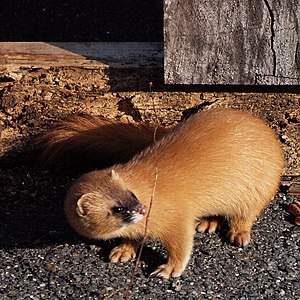Fire weasel
| Fire weasel | ||||||||||||
|---|---|---|---|---|---|---|---|---|---|---|---|---|

Fire weasel ( Mustela sibirica ) |
||||||||||||
| Systematics | ||||||||||||
|
||||||||||||
| Scientific name | ||||||||||||
| Mustela sibirica | ||||||||||||
| Pallas , 1773 |
The fire weasel , also called Kolonok or Kolinsky , Siberian weasel ( Mustela sibirica ) or Siberian mink , is a species of predator from the marten family (Mustelidae).
features
Fire weasels reach a head body length of 25 to 39 centimeters, a tail length of 13 to 21 centimeters and a weight of 360 to 820 grams, with males being significantly larger and heavier than females. Their fur is reddish-yellow in color in winter, very long and dense, the summer fur is darker, mostly brownish and thinner. Their bodies are elongated, their limbs and tail are relatively short.
distribution and habitat
The fire weasel is native to large parts of North and East Asia , its range extends from the Urals in Russia to the Sea of Okhotsk and south to Tibet and northern Thailand . It is also found in Japan and Taiwan , and it was introduced on Sakhalin . Its habitat is primarily forests, mostly in the vicinity of water. As a cultural follower , it can sometimes be seen in settlements and cities.
Way of life
Fire weasels live solitary and are active at twilight or at night. Hollow tree trunks, crevices in the rock, the roots of trees or structures of other animals, sometimes also buildings, serve as resting places. They line their nests with hair, feathers or plants. In the evening or at night they go looking for food, and their good sense of smell and hearing help them. They cover up to 8 kilometers in one night and are very good at climbing and swimming. In times of food shortage, they undertake pronounced mass migrations.
food
Fire weasels are skilful hunters who mainly feed on small mammals such as rodents , shrews and whistles . Birds and their eggs, frogs , fish and insects complete the menu.
Reproduction
The mating season is in late winter or spring. Several males follow a female and often fight each other for mating privilege. After a gestation period of around 30 days, two to twelve (five on average) young are born between April and June. These open the eyes at one month and are weaned after two months. They leave their mother around August. However, the young often stay together during autumn. In the wild, the average life expectancy is around two years and the maximum age is five to six years, animals in captivity can live to be eight years.
Fire weasel and people
The term Kolinsky (Russian Kolonok) is composed of Kola (Russian peninsula) and -insky (suffix expressing affiliation).
Fire weasels sometimes tear poultry, but they are generally viewed with benevolence as they consume many rodents believed to be pests. For this reason they have been introduced on some islands. They are sometimes hunted for their fur (see Kolinsky fur ), but overall they are widespread.
On the Red List of Endangered Species of the International Union for Conservation of Nature ( IUCN) Kolinsky are listed as Least Concern . The Washington Convention for the Protection of Species, CITES, adopted this species at the request of India in Appendix III of the Convention. It is referred to as a species with special trade regulations in India. The European Union assesses them in the EU Species Protection Regulation (EC) No. 338/97 or in the amendment by EC Regulation 407/2009 Appendix D as a species whose import quantity into the European Union justifies trade surveillance.
brush
The hair from the tail of the fire weasel is used to make high quality brushes . Only 1.5 grams of hair can be obtained from a tail, which is enough for three eight-strength brushes. Because so few tails come on the market, one kilogram of this hair cost up to 12,000 euros in 2012 .
Systematics
Fire weasels are included in the subgenus Lutreola within the genus Mustela , so they are more closely related to the European mink than to the weasels living in Europe . The Japanese weasel was at times classified as a subspecies of the fire weasel , but is now considered a separate species.
swell
literature
- Ronald M. Nowak: Walker's Mammals of the World . Johns Hopkins University Press, 1999 ISBN 0-8018-5789-9
- Chris J. Law: Mustela sibirica (Carnivora: Mustelidae). Mammalian Species 50 (966), Sep. 27, 2018; Pp. 109-118. doi : 10.1093 / mspecies / sey013
Individual evidence
- ^ The CITES Appendices. Retrieved on January 13, 2010 (English, The Appendixes of the Washington Convention on the Protection of Species, CITES).
- ^ Spiegel Online : "So": Brush maker - A hairy job . September 8, 2012. Retrieved January 13, 2018.
Web links
- Mustela sibirica in the endangered Red List species the IUCN 2009. Posted by: Duckworth, JW & Abramov, A., 2008. Accessed January 13 of 2010.
- WISIA Tracing Service for Endangered Species. In: WISIA Online. German Federal Agency for Nature Conservation, accessed on January 13, 2010 .
